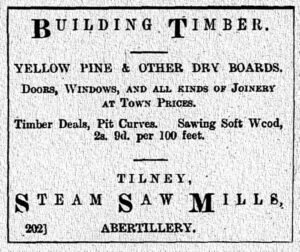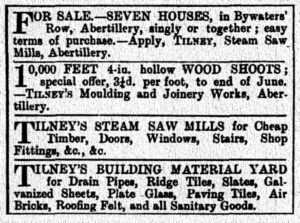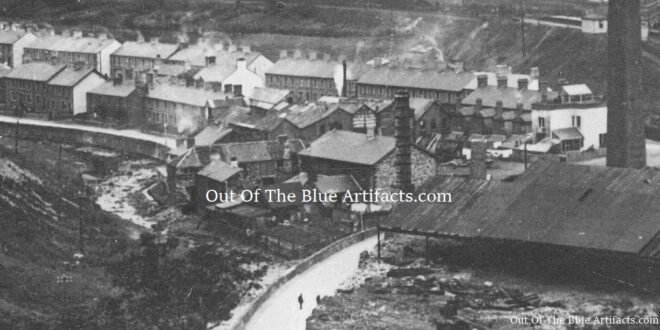Abertillery Steam Saw Mills and Mr Arthur Tilney.
Mr Arthur Tilney was born in November 1843 at Kirby Bedon, Norwich, Norfolk. The son of Mr Robert Tilney of Norwich, a young Arthur attended the local school and was educated by the Rev Dr Purnell. At 17 years of age, he left Norwich on medical advice and came to settle in the South Wales Valley’s, believing the mountain air would help his frail health this area was ideal for him.
Upon arrival in the valley Mr Tilney worked as a railway porter at Abertillery while lodging at Mills Row, Abertillery with Mr John Evans a farrier and his wife Mrs Maria Evans. (Mills Row was close to the Bush Inn and the Royal Oak Inn). Mr Arthur Tilney later became clerk for the Monmouthshire Railway Company and was the station master, though resigned when the Great Western Railway Co took over the old company.
Miss Annie James.
In 1865 Mr Tilney married Miss Annie James, daughter of Mr William James of Trevethin, later Abertillery.
In the 1870’s Mr Arthur Tilney was employed by Captain Phillips the tin plate works owner as an accountant at the Tin Works, Abertillery.
The Abertillery Local Board.
On Thursday 1st of March 1877, Mr Tilney was voted onto the Abertillery Local Board.
Abertillery Steam Saw Mills.
In the late 1870’s Mr Tilney made arrangements to purchase the Abertillery timber business from Mr Alexander James Esq, the timber merchant. Mr James was the son of Mr Edmund James of Clyn Mawr Ganol, a family of landowners at Blaenau Gwent. Clyn Mawr Ganol (middle farm) in Welsh, later Grosvenor Home and Penybont Nursing Home, a private Nursing Home on Portland Street, Blaenau Gwent.
 In 1879 Mr Tilney set up his newly acquired timber business opposite the tin works on Station Approach, close to the Railway Inn (as seen in the featured image above) these works grew into one of, if not the biggest timber businesses in South Wales. Mr Tilney named his business the Western Valley’s Steam Saw Mills. Mr Tilney also had a wheelwrights and built carts and caravans etc.
In 1879 Mr Tilney set up his newly acquired timber business opposite the tin works on Station Approach, close to the Railway Inn (as seen in the featured image above) these works grew into one of, if not the biggest timber businesses in South Wales. Mr Tilney named his business the Western Valley’s Steam Saw Mills. Mr Tilney also had a wheelwrights and built carts and caravans etc.
He not only made his money from timber but as the ads (below) show he also dealt with and traded in other goods. He didn’t seem content with just running his own business and branched out in other projects and schemes. It was reported that in conjunction with Rev O. S. Richards he set up the Western Valley Weekly News – the forerunner to the South Wales Gazette.
Waun Wern Terrace.
Mr and Mrs Arthur and Annie Tilney later lived at Waun Wern Terrace, close to Bridge Street, Abertillery.
 The Cwmtillery Brick Works.
The Cwmtillery Brick Works.
In 1892 Mr Tilney purchased the old Wallace’s Brickworks in Cwmtillery (Woodland Brick Works) he advertised for tenders from builders for the construction of new kilns and started to produce his own red bricks, examples of these can be seen in the Abertillery Museum.
The Abertillery Tin Works.
In 1899 Mr Tilney became director of the Abertillery Tin Works and later in 1900, set up his own company to take the tin works over, at this time they were known as the Glan Ebbw Steel Sheet Galvanising and Tin Plate Company Ltd.
Travelling Theatres.
He had his own land in the Carlyle Street area close to his works and he was a great supporter of the arts and entertainment industry and worked with, and organised travelling theatres to come to his grounds. These travelling theatre companies came to major towns on request. Travelling with the company were their own contracted carpenters, stagehands, musicians, actors and actresses and entourage, construct the wooden and iron kit-form theatre structures and provide entertainment for weeks or months however long the run. The company would then disassemble, pack-up and move on to the next venue. The council at the time took a dislike to these various companies as they never had to pay rates to the local authority as they were seen as non-permanent structures.
The Park Swimming Baths.
In his position of councillor, he became the leading force behind the construction of the open-air swimming baths at Abertillery, he was however bitterly opposed, yet he single-handedly fought to get the funding to have the baths built. He held fairs at his grounds and used the profits to help fund the building of the baths. He was also at the forefront of the movement in getting a recreation grounds and park constructed and laid-out at Abertillery.
At this time, he also worked hard in finding ways of beautifying the area, he introduced tree planting in Carlyle Street and Glandwr Street, there were a line of trees up through the middle of both streets in the early 1900’s, purchased goldfish and regularly stocked the pond at the park. He also instructed builders to plan for gardens to be laid out on all new house buildings in Abertillery and later he fought for land to be acquired by the council for public allotments.
The Pavilion Theatre.
In 1907, after the wane in popularity of the travelling theatres, Mr Tilney decided to have his own entertainment hall built upon his land. He arranged for the construction of the Pavilion Theatre, between Carlyle Street and Bridge Street, on the land where his saw mills were. He made the Pavilion into a grand theatre which boasted the second largest stage in South Wales, next to Cardiff’s New Theatre and with his contacts in the show business he had a vast amount of talent to exhibit.
The Empress Skating Rink.
In 1909, to cater for the rising popularity of roller-skating Mr Tilney set out on a new project, the building of the Empress Skating Rink, it was constructed upon his land opposite the Railway Inn, Abertillery. Many people, local and out of town, used the venue for roller-skating and it was also used for roller hockey games.
Empress Picture House.
In December 1910 after a marked decline in the pastime of roller-skating Mr Tilney moved with the times and turned the Empress Skating Rink into a picture palace which he renamed the Empress Picture House.
In 1910 Mr Tilney began to suffer ill health and retired from work. He was living in Carlyle House, Carlyle Street, Abertillery.
On the 1911 census he was living with his wife Annie. It was stated that they had 12 children together. His son Ernest De Caux Tilney, was theatre manager and employer. Mr Harold De Caux Tilney was listed as being the manager of the Public Hall, Abertillery.
The New Pavilion Theatre.
In 1915, with a rising population and a demand for entertainment Mr Athur Tilney reconstructed the old Pavilion and had it fully refurbished and enlarged. Soon after the project was completed, he left Abertillery and moved to reside at Newport.
The Death of Mr Arthur Tilney.
In November 1917 Mr Tilney sadly died at his home in Gold Tops, Newport aged 74 years. He was buried in Newport and his funeral was a private affair. He was spoke of being a leading figure in the history of Abertillery, a pioneer and visionary!
Points of interest – The featured image was taken in about 1899. The Abertillery Saw Mills can be seen (center) of the featured image surrounding the Railway Inn, to the left of the Railway Inn was a Blacksmiths and Wheelwrights which seems to have been later taken over by Mr Tilney. Mr Tilney’s grounds must have been where Carlyle Street was later built. Far right are the out-buildings of the Tin Works.
 Out Of The Blue Artifacts A Library of a lifetime of collecting
Out Of The Blue Artifacts A Library of a lifetime of collecting
